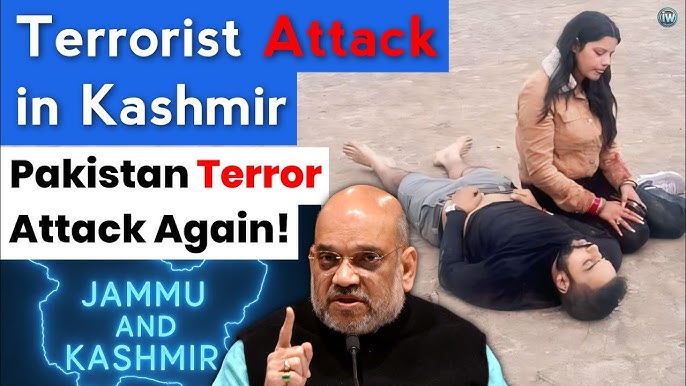
India-Pakistan Border Pahalgam Attack
The India-Pakistan Border Pahalgam Attack: Unraveling the Incident and Its Wider Impact
The recent India-Pakistan Border Pahalgam Attack has once again drawn global attention to the volatile nature of Indo-Pak relations, particularly over the sensitive Kashmir region. Occurring in one of the most scenic and historically peaceful areas of Jammu and Kashmir, this attack has raised serious questions about border security, intelligence lapses, and the fragile peace process between the two neighboring countries.
This blog offers a comprehensive breakdown of the incident, its background, political implications, and the future it signals for the region.
1. Kashmir: A History of Unresolved Conflict
The root of the India-Pakistan Border Pahalgam Attack lies in the long-standing territorial dispute over Kashmir. Since the partition of British India in 1947, the princely state of Jammu and Kashmir has been a source of conflict between India and Pakistan, resulting in three full-scale wars and numerous skirmishes.
Although Pahalgam, a town in the Anantnag district, is not situated directly on the Line of Control, its strategic value lies in its proximity to vulnerable infiltration routes and its economic importance as a tourist hub. Historically, areas like Uri, Kupwara, and Poonch have seen frequent attacks, but Pahalgam being targeted marks a worrying shift in terrorist focus—possibly aimed at disrupting both tourism and regional morale.
2. The Timeline of the India-Pakistan Border Pahalgam Attack
According to Indian security agencies, the India-Pakistan Border Pahalgam Attack occurred at dawn on a remote patrol route, about 15 kilometers from the main town. Reports indicate that a group of militants armed with automatic rifles and grenades launched a surprise ambush on Indian soldiers conducting routine surveillance.
The attackers are believed to have infiltrated from across the Pakistan-controlled side of Kashmir, taking advantage of dense forests and poor visibility in the area. A fierce gunfight ensued, lasting several hours, and led to the death of multiple soldiers, while some attackers managed to retreat or escape using underground hideouts. Search operations continued for days, involving drones, helicopters, and special forces.
Initial investigations point toward the involvement of Pakistan-based terror outfits, such as Jaish-e-Mohammed or Lashkar-e-Taiba, though no group officially claimed responsibility at the time of reporting.
3. Escalating Tensions: Political Reactions from India and Pakistan
India’s response to the India-Pakistan Border Pahalgam Attack was swift and stern. Prime Minister Narendra Modi condemned the attack, stating that those behind such cowardly acts will be punished. Union Home Minister Amit Shah convened emergency meetings with the chiefs of intelligence agencies and armed forces to assess the situation.
Meanwhile, the Indian Ministry of External Affairs issued a formal diplomatic protest to Pakistan, accusing it of failing to control cross-border terrorism. Pakistan, on the other hand, denied any involvement, calling the accusations “baseless and politically motivated.”
This cycle of blame and denial is all too familiar in Indo-Pakistan relations. However, the fact that such an attack occurred in a relatively calm zone like Pahalgam has raised the stakes significantly. The possibility of retaliation, similar to the Balakot airstrike following the 2019 Pulwama attack, cannot be ruled out if future investigations provide concrete links to Pakistan-based groups.
4. Ground-Level Impact: Civilians and Economy Under Threat
Pahalgam is widely known as a tourist paradise, hosting thousands of pilgrims each year during the Amarnath Yatra. The India-Pakistan Border Pahalgam Attack has deeply affected local sentiments. In the immediate aftermath, the local administration imposed curfews and suspended internet services to prevent the spread of misinformation and maintain order.
Many tourists cancelled their plans, and local business owners expressed despair over the sudden disruption. Hoteliers, pony operators, shopkeepers, and guides—all dependent on tourism—have appealed to the government for support and increased security presence.
Educational institutions in the area were temporarily closed, and students had to revert to remote learning. The psychological toll on children and families, especially those near the attack zone, is significant. The constant fear of violence has returned to a region that had begun to believe in a peaceful future.
5. The Bigger Picture: Regional Security and Global Attention
The India-Pakistan Border Pahalgam Attack also has wider regional implications. As tensions rise, countries like the United States, Russia, and members of the European Union have urged both sides to exercise restraint. China, which shares borders with both nations and has its own stakes in the region, also issued a measured statement calling for stability and dialogue.
India is also expected to raise the issue in international forums such as the United Nations and G20 meetings, emphasizing the need for a coordinated global effort against terrorism.
Security analysts argue that the incident may push India to intensify surveillance, construct stronger fencing along vulnerable stretches, and enhance cooperation with foreign intelligence agencies. A long-term policy shift may include advanced satellite monitoring, AI-powered surveillance systems, and cross-border reconnaissance missions.
6. Strategic Reforms: What Comes Next?
In the wake of the India-Pakistan Border Pahalgam Attack, there are likely to be several key reforms in India’s military and intelligence approach:
-
Increased Investment in Technology: Including AI-based threat detection, night-vision equipment, and drone patrolling in high-altitude regions.
-
Stronger Local Intelligence Networks: Building better rapport with local communities to detect early signs of militant movement or infiltration.
-
Revamped SOPs for High-Risk Zones: Redefining security strategies for areas previously considered low-risk, such as Pahalgam.
-
Public Awareness and Civil Defense: Introducing community-level defense initiatives and emergency drills in sensitive towns.
Such reforms are not only vital for preventing future attacks but also for restoring confidence among local populations and tourists.
Conclusion: A Critical Turning Point
The India-Pakistan Border Pahalgam Attack is a stark reminder that the path to peace in Kashmir is still fraught with danger. It exposes gaps in preparedness, but also reaffirms the resilience of India’s security forces and civil population.
As the Indian government works to uncover the full truth behind the attack and considers appropriate retaliation or preventive actions, the people of Kashmir—and indeed, all of South Asia—watch closely. The way forward must be rooted in a balanced approach: robust defense, vigilant diplomacy, and above all, a long-term vision for lasting peace.






